Abstract
This article explains how lessons of conscious guidance and control unfold and how to prepare for a first session. The first part explains the disciplinary framework as well as important concepts and principles. The second part describes the practical aspects, price, booking and setting up of the long-distance video application that is used during a long-distance session.
Preparing for a long-distance lesson of Conscious guidance and control
Summary
1- What happens during a long-distance session
What is the goal of long-distance lessons?
We can manage consciously only what we can measure objectively
Conscious guidance is guidance of a series of movements without any feeling guidance
Using video to learn and analyse a coordination without trusting to the feeling sense
Learning to analyse and solve problems by answering questions of cause and effect
2- Price, duration, booking, video conferencing application and tools to have ready for a lesson
Setting up the long-distance video conferencing application
What is the goal of long-distance lessons?
Learning to replace feeling guidance by a new conscious reasoned direction
modern Alexander technique themselves believe that their art is to transmit a form of body-knowledge through their educated touch.
There is nothing of the sort in these sessions. You are not going to be asked how you feel or where you may feel a bit easier, and nobody is going to suggest that when you have experienced the right feeling, then you should be equipped to change your habits of mind and of body and feel light and nice forever (or as soon as you direct your attention toward some feelings deemed appropriate).
These sessions of conscious guidance and control offer a radical revision of the technique revamped by F.M. Alexander’s first disciples. They mark a return to the initial purpose of the founder’s pedagogy: replacing the feeling guidance and the first-person pre-intellectual perspective by a new conscious (reasoned) direction. As you will see, they are based on the procedures set forth in the the four books written by F.M. Alexander —and not on some word-of-mouth transmitted by his disciples.
Aside from the practical results and the improvement in postural behaviour they ensure, these sessions offer a way to understand what F.M. Alexander means when he writes that he found it was necessary to replace his old instinctive (unreasoned) direction of himself by a new conscious (reasoned) direction.
-
to analyse the conditions of use present;
-
to select (reason out) the means whereby a more satisfactory use could be brought about;
-
applied reason in activity]
The goal of lessons is to learn how to Work with oneself in order to to gain practical experience at
-
conceiving reasoned intentions [decisions of movement] to change a complex behaviour and,
-
transforming reasoned decisions into actions and thereby increasing our discipline, that is “our authority over ourselves”.
This practical construction of how to Act according to structured orders, instructions, rules and principles is only possible when we start to realise how much our subjective habit, that is our spontaneous unthinking trust in our feelings and somatic perceptions, is the first and only real difficulty in apprehending and controlling our habits of thoughts and of body2.
LEONARDO DA VINCI. Quoted by Alexander, F.M., “Man’s supreme inheritance
To overcome the subjective habit3
-
to perform habitual acts by other than the habitual methods, that is as an effect of the conscious conception and the conscious direction of the mind, and
-
to control afterwards the effects of these informed decisions on our way of expanding the ‘mechanism of the torso’ and creating a solid equilibrium in activity.
Changing our “physical” behaviour and reactions from a set of verbal instructions describing a set of reasoned decisions:
-
represents a complex psycho-mechanical problem, that is, any change in our global attitude (in rest or activity) requires to think, perform and continue a series of coordinated decisions reasoned out to have beneficial mechanical consequences, and these guiding psycho-mechanical activities can only be performed through a new conscious guidance of our mind by means of coordinated verbal orders because they clash with our habitual movements guided by our feeling sense;
-
requires that all these decisions when obeyed in practice bring into play a series of mechanical effects (movements) which can be measured objectively with the tools of geometry. These concrete consequences must be measured (consciously controlled) in themselves and also in relation with all the other movements of parts which have been decided upon in advance.
The new form of reasoned guidance is just emerging through each new psycho-mechanical problem that is solved, and it can only grow when the effect [the new geometry of the torso] obtained through the use of the new guiding tools that the student constructs during a session are tested in practice and controlled consciously to be accurate, effective and in all aspects similar to the plan that has been drawn prior to its execution4. Therefore we are talking of a process of guidance and control, a circular process in which the control of our “solutions” to different psycho-mechanical problems informs our reasoning and reverberates on the quality and structure of our future guidance.
In the sphere of conscious guidance,
-
a ‘decision’ is a verbal order describing a criterion (or several criteria) of a movement of one part which has to be given (mentally) and carried out and then continued at the same time as other decisions of a series in order to implement a readjustment of the structure as a whole,
-
a ‘coordination’ is a concrete gesture composed of concerted segmental movements happening and ending at the same time otherwise called “readjustment” of the anatomical structure as a whole (starting with the most essential movements of the parts of the mechanism of the torso).
This pedagogy and the process of experiment that the student will learn to work out for himself is directly inspired by the Working Principle set out by F.M. Alexander.
This habit of “end-gaining5” is so ingrained that it will create a serious difficulty even where the teaching method is based on the “means-whereby6” principle, and the difficulty can be overcome only if both teacher and pupil at every step in their combined procedure, even the simplest, adhere strictly to the working principle I have set down—namely, that in a series of acts which have been thought out as the means whereby a given end can be satisfactorily gained, the primary act must not be considered as an end in itself, but must be directed and carried out and then continued as the preliminary means of carrying out the secondary act, and so on.
Changing one’s posture in activity in a deliberate manner leads to the necessity to make decisions, to represent the relations between these decisions and to apply these decisions in practice. Because these concerted decisions affect our postural behaviour, i.e. a concrete mechanical or kinematic chain, the coordination of these decisions can be objectively measured: it is possible to see on a film whether we have obeyed a series of orders of movements targeted at different bony parts, because if we have, the bones must have moved in the specified way and affected the distances and angles between the parts which can be MEASURED OBJECTIVELY.
When we say that we give consent to intentions to lengthen the torso for example, the resulting geometry of the torso must display new relationships between the different parts of the torso in the correct direction. Measuring the outcome of our experiment of conscious guidance, we know in which direction we are working —whether we are increasing our discipline7 or not.
An effective mental discipline can only be constructed from a concrete evaluation of a series of movements8.
Conscious guidance is guidance of a series of movements without any feeling guidance
What is a psycho-mechanical problem and why is it central to the learning of conscious guidance and control?
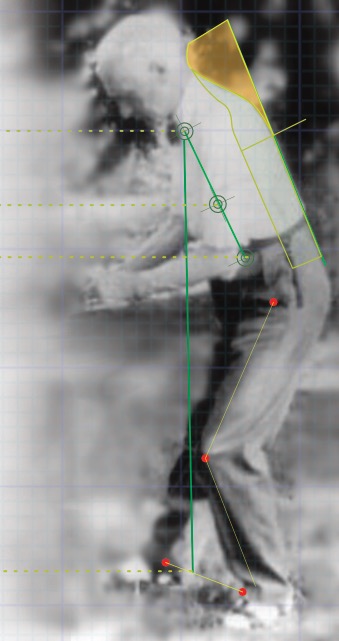
Accelerating one knee only, together with lengthening the mechanism of the torso in leaning forward is a complex psycho-mechanical problem when the results are measured (controlled) with an accurate geometrical model.
To give an example, let’s take the decision to accelerate the movement of one knee going forward faster than the other in the leaning forward gesture with the torso. Such an experiment offers a great training-ground for controlling the mental effects of our attempts at conscious guidance and control of our decisions, especially for this new order of movement is totally contrary to our habitual manner of leaning forward gesture, that is we have no feeling adjusted to this coordination of the movements of the ankles, knees and hips with the movements of the different parts of the torso.
Performing a gesture including these new criteria of movement for one knee will have mechanical effects in all the other parts of the chain structure which must be noted (controlled objectively because it is impossible to feel them all) and from that realisation, the operator can start experimenting with the guidance of the coordinated response of all the parts to obtain a lengthening of the torso despite the perturbation.
Using chronophotography (measuring the displacement of bony spot on frames of the video taken at regular intervals), it is possible to measure impartially whether
- (a) the knee has moved faster forward than the other or not and,
- (b) that the mechanism of the torso has lengthened according to the elements of geometry defined prior to the execution of the orders of movements defined by the teacher.
In such experimental conditions, it is easy to realise that obeying concerted decisions of movements has nothing to do with the feeling that we have experienced when doing so. A feeling, a sensation cannot help us perform new concerted decisions or check whether these decisions and no others have been performed in the activity.
On the opposite, measuring when our projection into actions of complex decisions results in the correct mechanical relations, can help us increase our discipline.
F.M. Alexander postulated that it should be possible to explore movements coordinations that we have never done before (the ‘unknown’ to us), that is, we can perform decisions of a new series of movements without having any feeling experience of the resulting gesture. A person with a scoliotic attitude feels upright and at rest when it clear that she is bending and rotating her spine. For her, standing without the scoliotic attitude represents an “unknown”, and in her spontaneous (somatic) evaluation, she would inevitably feel wrong, crooked and the new attitude tiresome, if she was to direct new movements that result in her standing upright and geometrically at rest. Therefore, the lessons of conscious guidance involve mandatorily to learn to be less dependent on the feeling sense, to detach ourselves from guiding ourselves with sensations and feelings.
The great hurdle in training oneself for discipline is the necessity to control the result of our mental efforts in a way that opens the possibility to improve one’s standard of judgement. This is why we do never judge or ask the pupil to evaluate his/her performance of a couple (or more) of decisions (intentions of segmental movements) by what it feels, by a subjective first-person appraisal, but we want to measure graphically, objectively, concretely the result of our intentions despite of how wrong it may feel. This is why all the lessons are filmed and why a great part of the lesson is dedicated to learning to see how movements of the different parts of the structure coordinate, how they happen at the same time and how they compose our habitual harmful positions as well as new, enhanced manners of using the anatomical structure as a whole.
From this basis, there are many other mental activities than guiding voluntarily the coordination of the movements of the anatomical structure which can be transformed by the same scheme of experiments and constructions. I am thinking of activities that are more often labelled as “mental” or “intellectual”: self-regulation of memory, of reasoning, of emotional reactions, etc.
The problem we set up from the start in a session is: can we follow verbal instructions to DO a series of simultaneous movements of the different parts of our anatomical structure in such a way that those movements can be objectively controlled as the exact performance of the model described in the instructions? In other words, can we use speech in a new way to bridge the gap between idealistic theory and actual practice, and subordinate our behaviour to reasoned instructions, rules and principles?
What we do during the session is working together to produce a video recording of your experiments of conscious guidance. This session will become your lesson.
By reviewing the film of your session, you will see:
-
how you have been able to give yourself verbal orders (instructions describing movements of the parts of your anatomical structure) to re-direct your own use of the different parts of the mechanism of the torso and
-
what effects these first attempts at obeying concerted orders have had on your whole shape as it is seen by an observer.
The lesson is all about the relationship between words (orders) and actions (coordination of movements) that you can establish for yourself at a certain time and how you could construct with this procedure in the future a better and more efficient discipline.
As the sessions are filmed, what you feel deep inside during the lesson is inconsequential: camera do not record feelings and subjective sensations. The session is not a somatic imprinting; it is about how we reason, command and obey series of orders to perform coordinated actions.
I insist, each session is dedicated to creating a video of your experiments of conscious guidance and control and to learn how to observe the unfolding of coordinated movements in activity: you are filmed while using verbal orders (directions of preliminary movements or means whereby movements) which I will give verbally, for you to readjust in practice your coordination of the torso as a whole. If you remember Dewey’s introduction to Alexander’s third book, “the Use of the Self, its conscious direction in relation to diagnosis“, the session will explain what is meant by “experimentally controlled acts9” and how you can use these tools to improve your guidance and control over yourself.
My contribution consists:
-
in explaining at great length the verbal orders you are going to use to plan a connected series of decisions of movements, how they are to be conceived and used by the mind (the guidance phase) and
-
In helping you to see how you can judge objectively (the control phase is done by watching your performance on video) the gesture you have performed as a result of giving yourself some simple intentions of movements: quickly you will be able to reason from what you observe of your gestural behaviour which decisions you want to keep to make some movements more visible, which decisions you want to add to stop some unwanted movements which are happening spontaneously (out of your control) when you are readjusting your structure.
This pedagogy based on Delarte’s Laboratory method of Instruction10 or laboratory method of experiments introduces a new way to think out and react to psycho-mechanical problems of coordination: it is the possibility to trust reason and to plan different reactions to events that have not be recognised as a known feeling-in-the-body.
After performing a readjustment of the whole torso by giving consent to a manageable number of decisions of movement at the same time (altogether), you are then invited to observe your performance and to reason about :
-
what movements we want to see in the next experiment (and with them the decisions which the young Alexander called “orders of definite performance”) and
-
what are the movements you have made spontaneously in response to correct orders and that we do not want to see occurring when you translate these correct orders into action (F.M. called the decisions referring to stopping unwanted movements subconsciously performed: “orders of definite inhibition11“).
The teacher of conscious guidance and control will ask you many questions to help you construct a clear conception of the movements which make for incorrect and correct adjustment of the mechanisms and to improve your skill (a) at directing your mind to form reasoned, strong and stable series of intentions, and (b) at applying these intentions of definite inhibition of incorrect movements and of definite performance of coordinated in activity.
After reasoning in this way, you are invited to perform the global readjustment once again without looking at your image. In this way, you can evaluate whether you can subject your behaviour to reasoned decisions and how you can develop from that stage more experiments of conscious guidance on your own.
If you are recorded on video as capable of creating such an experiment with the sole verbal guidance of a teacher, readjusting your anatomical structure in the process, it is believed that all you need is remembering the instructions of guidance and of control (which are recorded with the video) to make the same experiment on your own. These sessions are designed to empower you to work on your own. The sessions will not change you; they will give you the tools to conduct a system of inquiry into your own guidance so that you can change yourself, provided you work on your own.
The teacher of conscious guidance and control will never make the change for you.
This is how all the lessons unfold. Each lesson will be more difficult than the previous one until you decide to stop having lessons.
The cost of a session is 50€ (50 European Euros). You can pay with your credit card using PayPal: link to pay.
PayPal will apply automatically the correct exchange rate at the time of the session when you pay in Euros through the PayPal link.
You do not have to pay before a session.
The price is for a single lesson with one individual. You can invite other persons to be present in your room (or in the virtual Zoom room), but I only answer questions and work with the individual who has booked the lesson.
I do not offer packs of lessons and ask students to engage in advance in a series of sessions. You have to make a fresh decision for each new session and book the lesson by email.
To have a lesson with me, it is very simple: you just need to book a sixty-minute session sharp, at a time you know you are not going to be disturbed. I book lessons solely using email contact (each lesson must be agreed to in written form): mailto:jeandomasoero.iat@gmail.com
In your first email, indicate in which city you live in order for me to calculate in which Time Zone you are and at what time we can share a meeting.
I do NOT use a virtual agenda on the internet and I book every lesson depending on the Time Zone of my pupils. For example, if your time zone (Dublin) is UTC while I am in (France) UTC+1.
In Irish time my business hours are
Morning:
From 08:00 to 10:00 {8:00-9:00, 9:00-10:00, 10:00-11:00} Greenwich Mean Time
Afternoon:
From 13:00 to 17:00 {13:00-14:00, 14:00-15:00, 15:00-16:00, 16:00-17:00} Greenwich Mean Time
These opening hours are just indicative: in certain conditions (for example when the Time Zone difference is too great), I will adapt my hours to suit the need of the students on the other side of the world.
I book lessons in my agenda on the first come first serve basis. As soon as a lesson is booked, I send you an email with a link to my teaching room on the video conferencing application Zoom.us.
IMPORTANT: Zoom is not like Skype. We do not need to connect in any way or exchange our Username before a lesson. There is no Username on Zoom: you just need to have my Zoom Meeting number.
To start our session, YOU just need to click on the Zoom Meeting number link I provide when I confirm a lesson. This is how it looks when a lesson is confirmed:
Jeando Masoero is inviting you to a scheduled Zoom meeting.
Topic: G.S.’s 5th Zoom Meeting with Jeando
Time: Friday, the 16th of August, at 16:00 CEST (Köln, Germany)
Join Zoom Meeting
The zoom Meeting number-link (shown above) is not a live link. When you receive the valid Zoom Meeting number link after booking a lesson, do not click on it before the time of your lesson as you would enter the teaching room when somebody else may have a lesson. Respect the anonymity of the students or teachers!
I do not give long-distance lessons with the application Skype but with another tool called Zoom.us which offers many more possibilities of exchanging diagrams and work with videos during the sessions. It is also more robust and offers a way for the student to record their sessions with me directly on their computer which is a MUST for learning something as complex as the initial Alexander technique.
You need first to download the free Zoom application (called Client) https://support.zoom.us/hc/en-us/articles/207373866-Zoom-InstallersZoom.us adapted to your computer.
The video camera of your computer is going to record the video of your session for you while you are working with me. Once you have downloaded the zoom-client, open it on your computer.
When the application Zoom Client you have downloaded is open on your computer, you will see this window:
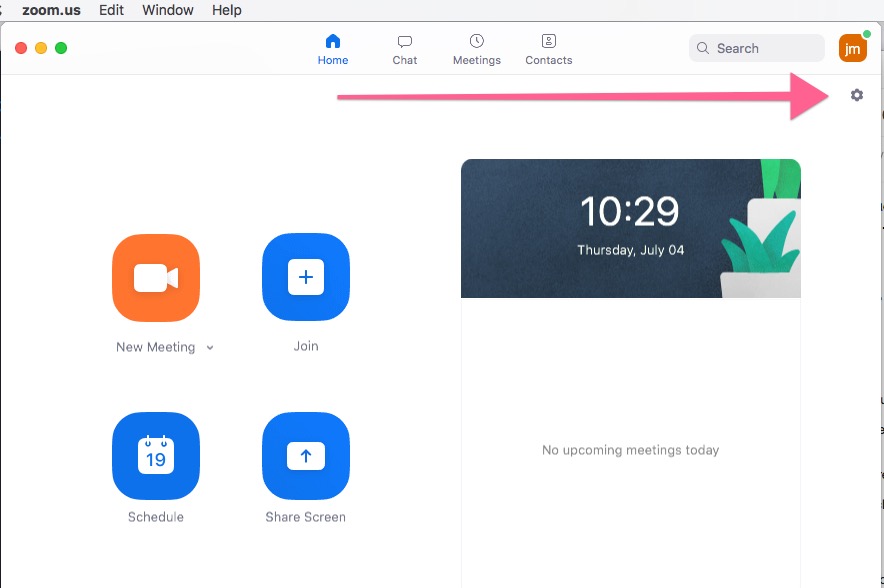
When you click to open the Zoom Client application this is the first Window you will see. The cogwheel on the top right hand side is the Preferences or Settings.
The red arrow that I added on the top right-hand side (at the top of this picture) indicates the button you need to click to start configuring the application for our lesson. Clicking on the little cogwheel will open the Preferences Panel and you will see this window: Settings.
You need to make sure that your camera and microphone are correctly connected before starting your lesson.
Click on the second thumb: Video
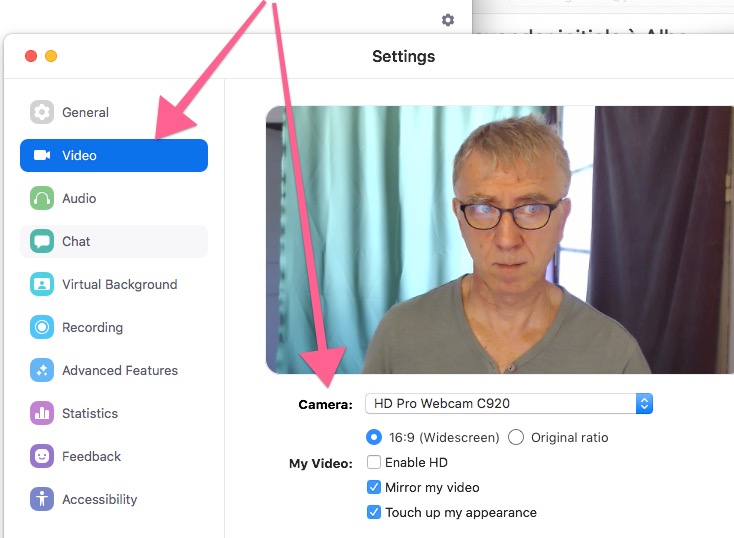
The second thumb of the Settings will display the image filmed by your video camera. If the computer does not recognise your camera, the image on the right will be black.
Check that you have an image and that the camera listed on the right is the one you want to use. To choose the camera, click on the menu shown beneath the long red arrow. When the name of a camera is selected, you will see exactly what the zoom film image will be.
Remember to take off any obturator placed on the lens of your camera.
You can use this image to establish the scene where the session is going to take place.
Place the computer camera in such a way as to be seen from head to foot, sideways, at an arm length from a wall:
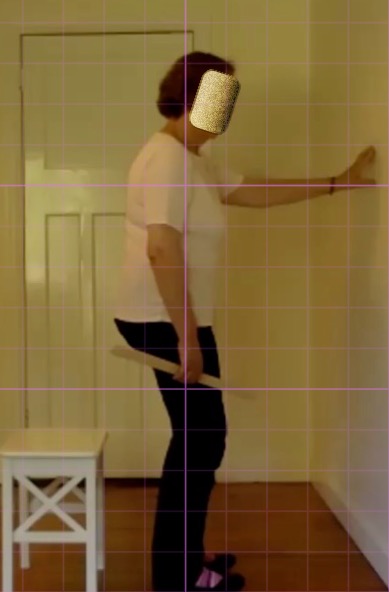
Stand in front of your camera, facing a wall at about an arm length away from it with a chair behind your legs.
Your camera is going to present a different frame (this still picture has been cropped) and there will be no gridlines which have been added after the session to help observe the movements of different parts of the anatomical structure. Nonetheless this image presents how you are going to set up your camera to be filmed during a session.
You can then click on the third thumb of the Zoom Settings: Audio. Here is a picture displaying the Audio window of the zoom settings when a microphone (Sennheiser USB headset) is correctly selected. Selecting and testing your microphone is essential so that the teacher can hear your answers to his questions and for you to control how you answered different problems when first confronted with them.
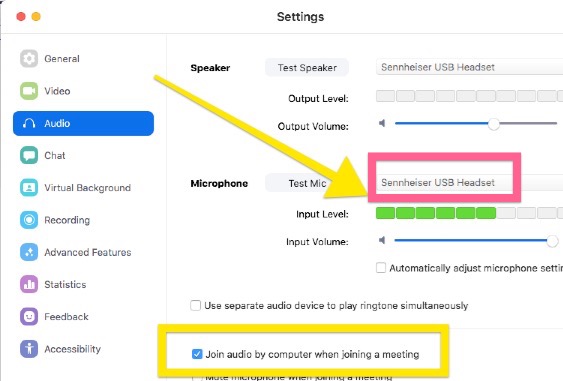
This image shows the window associated with the Audio Thumb of the Zoom Client settings. Select your microphone in the menu indicated by the yellow arrow.
You need to check your microphone (second yellow arrow on the picture above).
You also need to speak to test the Input level. The “input level” bar will show how strong is the input when you speak in your microphone. Three green bars is more than enough.
When we work on BREATHING and VOICE PRODUCTION, it is better to use a USB microphone rather that the microphone of your computer but that is not required for the first few lessons.
This is all you need to adjust to record a first session.
To form new conceptions of our gestural reactions we need different tools: most of these tools are intellectual system of representation (geometric visuospatial language, rules of geometry, etc…) which can be communicated during the session by discussing diagrams and photographs, but some are very simple objects that the student must have at his disposition during each lesson.
These simple practical tools are essential to create controlled experiments of conscious guidance and control and reveal
(a) the complexity of the movements of the different parts of the organism and
(b) our capacity to command concerted movements of the different parts of the organism12 through the use of verbal orders of movement (means-whereby).
-
- A straight wall, or a vertical post of some sort, constitutes a perfect target which we are going to use as a reference 2D surface to measure the movements of different parts necessary to align various bony structures on the same plane,
-
A couple of straight sticks of the same length which I call rulers.
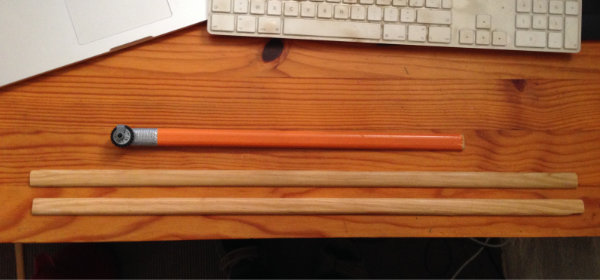
At first, two simple rulers (straight sticks) are used to measure and control the effect of different intentions of movements of bony parts aimed at establishing in practice a visuospatial vertical plane and a series of necessary geometrical relations between different bony parts of the torso and anatomical structure.
The rulers will be used for two different purposes:
- a ruler can display a concrete representation of the direction of a line between two bony spots of the anatomical structure. The student can therefore plan different movements of the bony parts to orientate consciously the resulting line after an adjustment of the movements. Placing the rulers against the two spots after a conscious readjustment will reveal whether the correct relationship has been established between the spots.
- rulers can be used to ensure that the distance between two different bony spots and a surface of reference is growing or decreasing.
On this picture, there are two rulers (pieces of wood, straight, same length approx. 25 inches).
For advanced students, a ruler with a wheel attached at one extremity will be required to measure the vertical displacement of a bony structure relatively to another fixed spot of the anatomical structure.
Here is an example of how these rulers can used to control [measure] the distance from the reference surface to some bones of different parts of the torso:
Two straight sticks of the same length and a wall are sufficient to start the process of conscious control of a series of intentions of movements.
-
a book, (or any flat 2D surface which can serve as a portable plane)
-
two pencils, which we will use to create simple models of movements between two different levers or more.
Very often, in order to become able to project a series of movements correctly, the pupil will need to reason and analyse the movements of parts of the anatomical structure in a disembodied way, in order to see these movements as disconnected from his own feeling conception of these movements.
All these simple objects are the tools of control you will need for the session of conscious guidance and control.
You are never asked to disrobe during a session. Wear clothes which do not restrict day-to-day activities. Sports clothing (pants, leggings, yoga wear) is not required. Wear the same clothes you would wear in the workplace.
It is better to wear light colour clothes because the video will record contrasts much better and you will discern the movements composing your gesture as a whole with more ease. Avoid black and dark colours.
The most important tip is to direct the light at you and not at the camera.
Place the camera so that the lightning is behind it and directed at you. Avoid any large source of light behind you pointing at the camera. There are many lighting tutorial on the internet, but keep it simple. There is no need of extra lighting to make a good working session video.
Footnotes
- “The fact to be faced is that the human self was robbed of much of its inheritance when the separation implied by the conception of the organism as “spirit,” “mind,” and “body” was accepted as a working principle, for it left unbridged the gap between the “subconscious” and the conscious. This gap still remains unbridged by the studies, scientific or otherwise, which have been stimulated by the conception of separation. I venture to assert that if the gap is to be bridged so that the self may enter into and enjoy the fuller benefits of “man’s supreme inheritance,” it will be by means of a knowledge, gained through practical experience, which will enable man to inhibit his impulsive, “subconscious” reaction to a given stimulus, and to hold it inhibited while initiating a conscious direction, guidance, and control of the use of himself that was previously unfamiliar”. (Alexander, F.M.; The universal constant in living, Chaterson L.t.d., 1942, third edition 1947, p. xxxi)
- “And in all such efforts to apprehend and control mental habits, the first and only real difficulty is to overcome the preliminary inertia of mind [the mind sticks to feeling] in order to combat the subjective habit.(Alexander, F.M.; Man’s Supreme Inheritance (Third Ed., 1946), p. 63, “Habits of thoughts and of body)
- “The mental habit [preconception] must be first attacked, and this mental habit usually lies below the level of consciousness; but it may be reached by introspection and analysis, and by the performance of the habitual acts by other than the habitual methods — that is, by physical acts performed consciously as an effect of the conscious conception and the conscious direction of the mind (Alexander, F.M.; Man’s supreme inheritance, Chaterson Ltd, 1910, reprinted 1946, p. 128, Chapter: “The Processes of Conscious Guidance and Control”)
- “The art of architecture does not consist in knowing the number and nature of elements of constructions, but further to model these substances in such a way that their coordination form a monument in all aspects similar to the plan that has been drawn prior to its execution” (Delsarte, F.; in Benoît Gauthier. “Édition critique de manuscrits de François Delsarte et examen de leur pertinence épistémologique dans la formation d’un corps scénique moderne ».” Thèse. Montréal (Québec, Canada), Université du Québec à Montréal, Doctorat en études et pratiques des arts., 2011. Translation, Masoero, J.D.)
- The end-gaining habit is the mental habit of trusting to the feeling sense and concentrating on what we feel in order to perform complex gestures involving the direction and performance of concerted series of movements.
- The ‘means whereby’ principle is a new mental principle which requires to form a reasoned conception of the gesture to be performed (instead of trusting to feeling) and to coordinate guiding and controlling orders of movements as well as the mechanisms to translate these orders into coordinated movements which result in the gesture desired.
- From the Ancient Greek, disciplina, the action of learning, of training oneself to ACT in accordance with orders, instructions, rules and principles.
- “We don’t believe a person inhibits unless we SEE the concrete result. This concreteness is one of the things that differentiates us from New Thought and other isms and cults. We will not deal in so-called mental things as such. Every mental order we project has a discernible physical aspect —a concreteness. (Westfeldt, L.; F.M. Alexander Aphorisms, 1931-34, 1939, p. 6)
- “The vitality of a scientific discovery is revealed and tested in its power to project and direct new further operations which not only harmonise with prior results, but which lead on to new observed materials, suggesting in turn further experimentally controlled acts, and so on in a continued series of new developments. Speaking as a pupil, it was because of this fact as demonstrated in personal experience that I first became convinced of the scientific quality of Mr. Alexander’s work. Each lesson was a laboratory experimental demonstration. Statements made in advance of consequences to follow and the means by which they would be reached were met with implicit scepticism—a fact which is practically inevitable, since, as Mr. Alexander points out, one uses the very conditions that need re-education as one’s standard of judgement. Each lesson carries the process somewhat farther and confirms in the most intimate and convincing fashion the claims that are made. As one goes on, new areas are opened, new possibilities are seen and then realized; one finds himself continually growing, and realizes that there is an endless process of growth initiated. (Dewey, J.; in Alexander, F.M.; The Use of the Self, Its Conscious Direction in Relation to Diagnosis, (Third Ed. Centerline Press 1946), p. xix)
- “In the laboratory method of instruction, the student is taught the principles of the art, the instruments and elements are named, the problems are set, and he is required to experiment for himself under the eye and ear of the teacher; he is then shown wherein he fails or succeeds. Only as the individual [reason] is reached, can instruction be made effective ; and each teacher as well as each student will, soon or late, find out how farcical, without supplementary practice given to the individual, is the attempt to treat large classes. (Kirby, A.N.; “Public speaking and reading, A treatise on Delivery according to the principle of the New Elocution”, 1895, Boston, p. 8)
- “I may briefly explain orders concerning definite inhibition by stating that the teacher will have to deal with incorrect movements unconsciously performed. These movements occurring at the moment when the teacher dictates the orders (conscious guiding orders of definite performance) necessary to bring about coordination of the different parts of the mechanism assert themselves and become primary, and hinder the performance of the correct and coordinated movements as ordered. It is, therefore, as necessary to order the inhibition of incorrect and unconsciously performed acts as to give orders (conscious guiding orders) which will secure the coordinated use of the mechanisms involved”. (Alexander, F.M.; Re-education of the Kinaesthetic System, 1908)
- “The method is based firstly on the understanding of the co-ordinated uses of the muscular mechanisms, and secondly, on the complete acceptance of the hypothesis that each and every movement can be consciously directed and controlled“. (Alexander, F.M.; Man’s Supreme Inheritance, (Second Ed. Revised, 1918), p. 134)

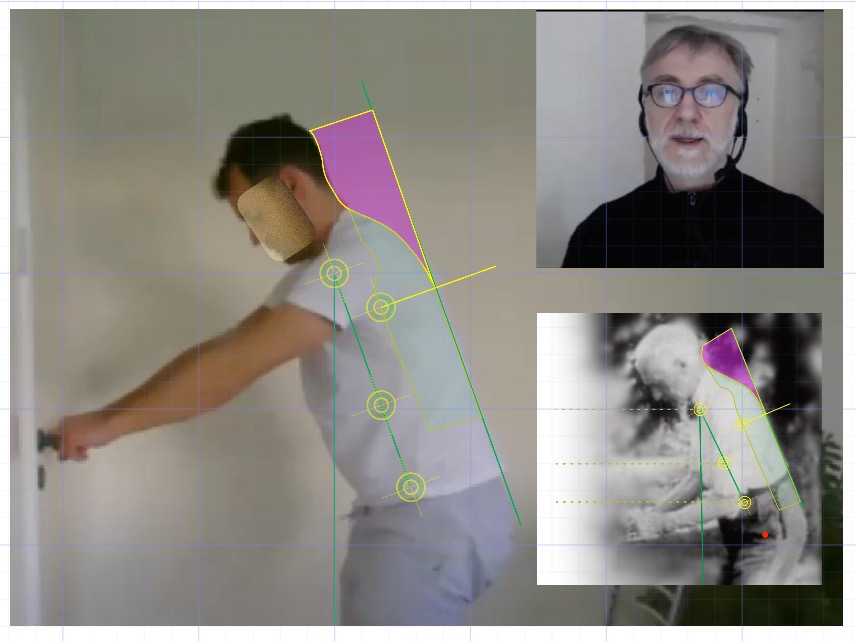
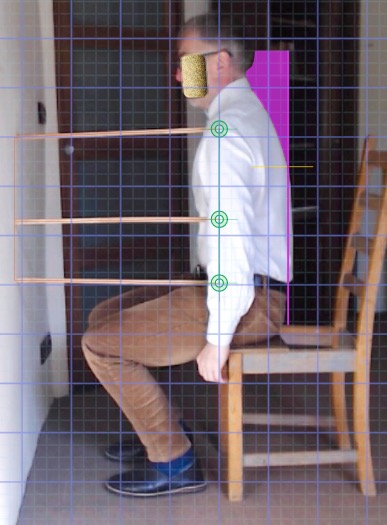
Leave A Comment